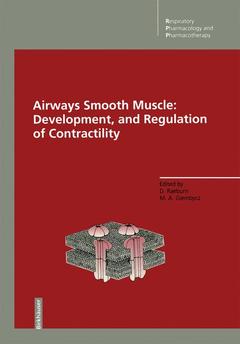Airways Smooth Muscle: Development, and Regulation of Contractility, Softcover reprint of the original 1st ed. 1994 Development and Regulation of Contractility Respiratory Pharmacology and Pharmacotherapy Series
Langue : Anglais
Coordonnateurs : Raeburn David, Giembycz Mark A.

Most studies on autonomic innervation of smooth muscle have focused on the short-term mechanisms involved in neurotransmission in physiological and pathophysiological conditions. However recent obser vations of the long-term plasticity of this system, i. e. its capacity for regeneration and for compensatory change in pattern of innervation and expression of cotransmitters and receptors in ageing, following surgery, trauma or in disease, have indicated that an understanding of the mechanisms involved could influence the design of therapeutic regimes. There is increasing evidence for long-term communication between nerves and smooth muscle cells during development and throughout adult life. To date, the trophic interactions between nerves and airway musculature have attracted little interest, consequently, much of the information presented here is drawn from studies using other smooth muscles. However, the questions posed about trophic interactions dur ing development apply as much to airways smooth muscle neuroeffector systems as to other autonomic neuroeffector systems. These are: i) How do developing nerve fibres know where to go and how do they reach their target sites? ii) What determines the density and pattern of inner vation at reaching the effector? iii) How do the nerves survive and maintain their position once established? iv) What factors influence neurochemical differentiation such that genetically multipotential neu rones are triggered to synthesize one or combinations of neurotransmit ters? v) What influence do nerves have on the structure, function and receptor expression of their effector cells? vi) How do diseases interrupt these processes? - see [1].
1. Trophic Factors and the Control of Smooth Muscle Development and Innervation.- 2. Airways Smooth Muscle Cell Growth and Proliferation.- 3. Mechanical Properties and Function of Airways Smooth Muscle.- 4. Myogenic Control of Airways Smooth Muscle and Cell-to-Cell Coupling.- 5. Electrophysiology of Calcium Channels in Airways Smooth Muscle.- 6. Electrophysiology of Potassium Channels in Airways Smooth Muscle.- 7. Effects of Ageing upon Airways Smooth Muscle Contractility.- 8. Immunological Changes of Airways Smooth Muscle Reactivity.- 9. Epithelium-Dependent Regulation of Airways Smooth Muscle Tone.- 10. Influence of Cartilage on Airways Smooth Muscle Contractility.- 11. Control of Tracheobronchial Microvascular Permeability.- 12. Influence of Respiratory Tract Fluid on Airway Calibre.
Date de parution : 06-2012
Ouvrage de 424 p.
17x24.4 cm
Disponible chez l'éditeur (délai d'approvisionnement : 15 jours).
Prix indicatif 105,49 €
Ajouter au panierThèmes d’Airways Smooth Muscle: Development, and Regulation of... :
Mots-clés :
Airways; Physiologie; Physiology; cells; glatte Muskulatur der Atemwege; smooth muscle; surgery
© 2024 LAVOISIER S.A.S.



